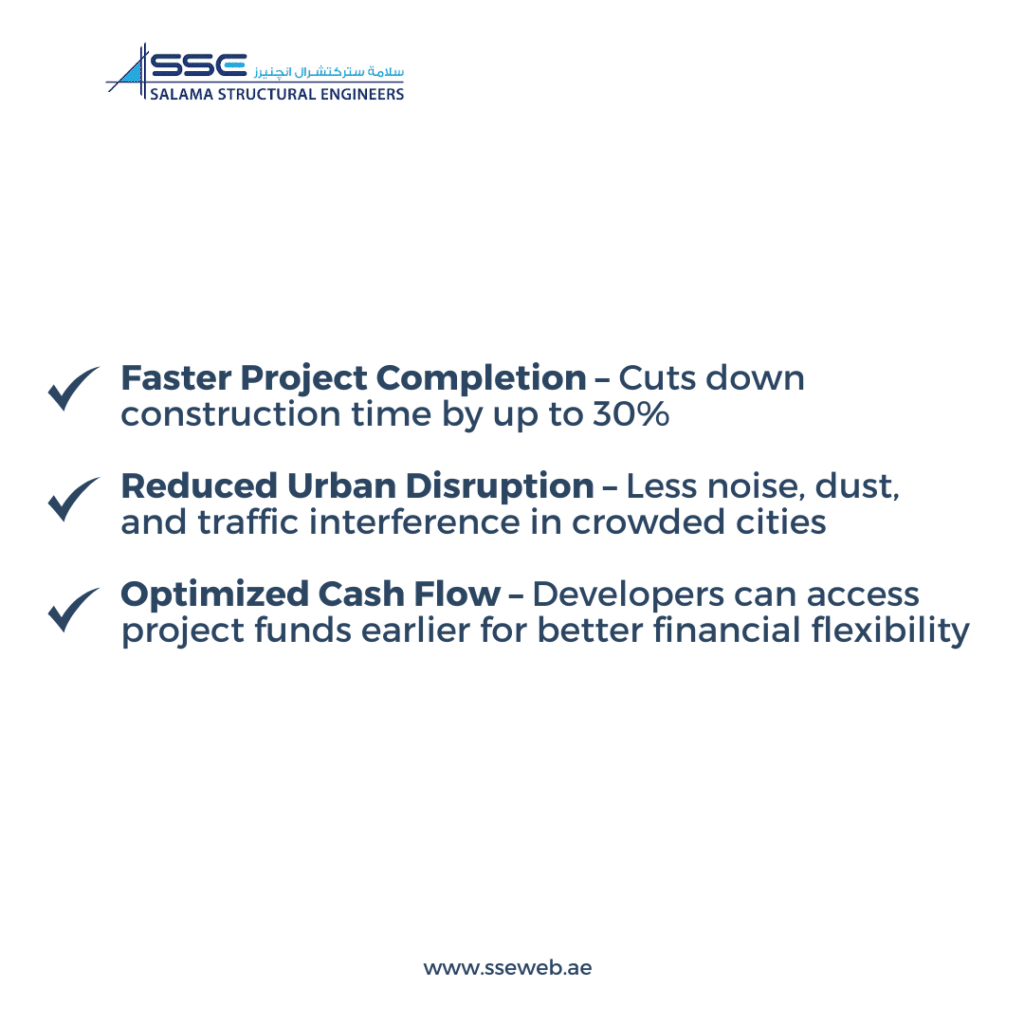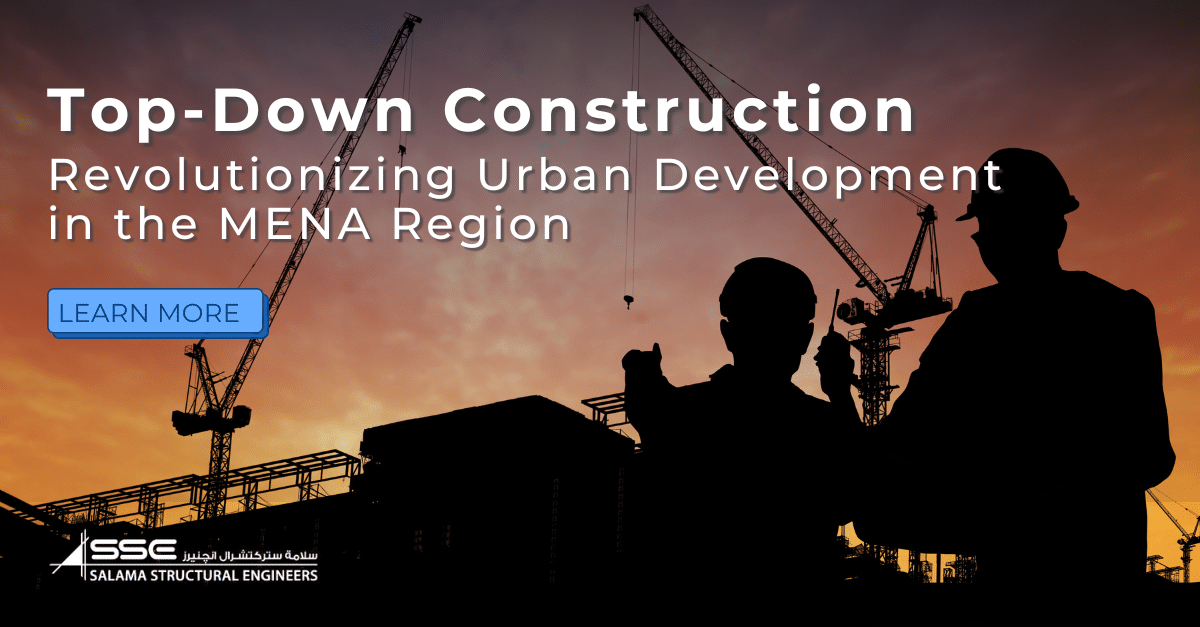The Power of Top-Down Construction Revolutionizing Urban Development in the MENA Region
In the fast-paced, ever-evolving landscapes of the UAE and Egypt, where urbanization demands innovative solutions, top-down construction has emerged as a groundbreaking method in structural engineering.
Every process improvement brings significant value, especially in an industry where time is money. With cost efficiency being crucial, each enhancement plays a key role in achieving that goal. Top-down construction accelerates project delivery by overlapping typically sequential tasks, enabling faster completion without compromising safety, structural integrity, or quality. This approach is instrumental in urban environments where space is limited, and minimizing disruption to surrounding areas is essential.
But what exactly is top down construction, and why is it reshaping the way we build?
“Top-down construction is not just a method; it’s a mindset shift in how we approach urban challenges. It allows us to think holistically about space, time, and efficiency in densely populated cities.”
— Dr. Mahendra Kumar, renowned structural engineer and author of Innovative Practices in Urban Construction.
What Is Top-Down Construction?
Top-down construction is a technique where both the above-ground superstructure and the below-ground substructure are built at the same time. When comparing the critical path of a conventional construction sequence to top-down construction, it’s evident that top-down construction allows for the overlapping of tasks that were traditionally sequential. In conventional construction, each stage must be completed before the next can begin, whereas top-down construction ‘stacks’ these stages, enabling multiple phases to progress simultaneously.
Graphic of Gandtt chart
Conventionally, a site is first excavated, followed by foundation work, which then enables contractors to build up to ground level. Once this is completed, construction of the superstructure can begin. In contrast, top-down construction starts with foundation work at ground level, and once that’s finished, work on the upper levels can commence. Notice how excavation and below-ground structures are bypassed, and construction begins above ground. As the superstructure progresses. Contractors can now begin excavating around the existing foundation towards the desired basement level while casting basement slabs; this is an example of the task stacking mentioned earlier.
Graphic of TDC methodology
The result is a more efficient site where multiple objectives are pursued simultaneously, with tasks not interfering with each other, and time is saved by bypassing the typical sequence. This change in methodology comes with new circumstances that need to be considered structurally to proceed safely.
The Challenges of Top-Down Construction
To begin with, reordering construction methodologies necessitates a thoughtful approach to several factors typically addressed in a project’s initial phases. These include challenges such as unbraced vertical elements, potential differential pile settlement, ensuring proper access for material delivery, and maintaining adequate ventilation, among others. Each of these aspects demands unique, often unconventional solutions that differ from standard procedures, requiring careful planning and coordination to ensure they are effectively managed throughout the construction process.
Unbraced vertical elements are often a point of concern in top-down construction projects. This issue arises because these elements are typically surrounded by parking slabs, which, once completed, can provide the necessary horizontal bracing for the building. In the interim, before the slabs are in place, these vertical elements can be vulnerable to instability, which requires engineers to implement temporary bracing. Depending on the situation cable bracing, steel struts or even overdesigning those elements to be safe during the construction period are a few of many strategies engineers use to overcome this issue.
The second barrier is pushback from industry stakeholders. As with any new challenge, it takes time and thorough due diligence for market partners to familiarize themselves with and gain trust in these new processes. While the aggressive application of TDC offers significant cost and time benefits, it also presents higher risks and more complex execution. Organizations must be willing to take the lead in overcoming these challenges to stand out in competitive markets such as the Middle East.
The final challenge is calculating whether the time saving is worth the difficulties presented and this decision usually involves all the stakeholders inputs.
Why Top-Down Construction Matters
- Speed and Efficiency
In cities like Dubai and Cairo, where tight timelines and delays can be costly, top-down construction allows multiple work phases to occur simultaneously. This reduces overall project duration and ensures quicker completion of essential structures, benefiting developers and consumers greatly. - Minimizing Disruption
An expedited project completion ensures reduced disruption caused by construction related transport. Additionally, Excavation in crowded urban environments can cause significant disruption to surrounding areas. By sealing the surface early, top-down construction minimizes noise, dust, and other disturbances—critical in regions like the UAE, where proximity to bustling urban centers is a given. - Optimizing Cash Flow
In different regions worldwide, consumer protection laws minimize investment risk by limiting developers’ sales and financial freedom until certain milestones are achieved to ensure developers follow through with the project. Using the UAE as an example, developers must fulfill specific criteria before the Real Estate Regulatory Authority (RERA) grants permission to commence off-plan unit sales. The law requires developers to either complete 20% of the project, deposit an amount equivalent to 20% of the construction value into an escrow account, or provide a bank guarantee for the same amount. The Top-Down construction method can achieve this percentage more efficiently than traditional construction methods, resulting in an earlier release of the funds.
In the MENA region, where cities like Dubai are renowned for their iconic skylines and Cairo for its growing infrastructure demands, adopting top-down construction is not just a trend—it’s a necessity.
Did you know?
Time Savings: Projects using top-down construction methods typically achieve up to 30% faster completion times compared to traditional bottom-up methods.
(Source: Construction Management Research Report, 2021)
Cost Reduction: Utilizing top-down construction can save up to 20% of total project costs depending on the type of application, particularly in urban environments with high land value and dense populations.
(Source: Building and Construction Performance Studies, 2020)
SSE Expertise Leading Top-Down Construction Innovations
Top-down construction is not a one-size-fits-all solution. It demands precise planning, advanced engineering, and collaboration between architects, structural engineers, and contractors. Our team at SSE specializes in designing and executing projects using cutting-edge methods like top-down construction, ensuring efficiency, safety, and sustainability in every build. SSE is currently working on three projects that have utilized different applications of top-down construction: the “Infinity Tower” in Cairo, Egypt, the “Al Habtoor City Tower” in Dubai, UAE, and the “Al Habtoor Grand Residences” in Dubai, UAE. Despite the initial challenges, each project demonstrated the value of adopting top-down construction, with the primary benefit being the ability to expedite construction.
As urban centers in the MENA region continue to grow, top-down construction will play a vital role in shaping skylines and supporting underground infrastructure. It is a testament to how structural engineering is evolving to meet the challenges of modern cities.
If you’re looking to innovate and optimize your next construction project, let’s explore how top-down construction can elevate your vision.
SSE is a leading engineering consulting firm specializing in the design of super-tall buildings, mega structural steel projects, and seismic design. With over 150 experts, including structural engineers, architects, and MEP specialists, SSE delivers innovative, value-driven solutions across diverse sectors, including industrial, residential, hospitality, and healthcare. Dedicated to quality and client satisfaction, SSE combines creativity and expertise to shape impactful projects across the MENA region.



